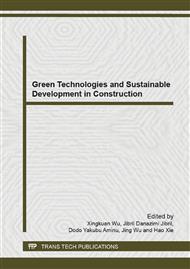[1]
American Society for Testing and Materials (2008). Standard Specification for Mortar for Unit Masonry (ASTM C 170 -00) ASTM C170, USA.
Google Scholar
[2]
American Society for Testing and Materials (2005). Standard Specification for Aggregate for Masonry (ASTM C 144 -05) ASTM C144, USA.
Google Scholar
[3]
British Standards Institution (2002). Aggregates for mortar, (BS EN 13139), UK.
Google Scholar
[4]
Jozef, Jasiczak and Zielinski, K, Effect of protein additive on properties of mortar, J. of Cement and Concrete Composites, ScienceDirect. 28(5) (2006) 451-457.
DOI: 10.1016/j.cemconcomp.2005.12.007
Google Scholar
[5]
Benito, Casu, Fabio, and Tegiacchi, Alkylsulfonated polysaccharides and mortar and concrete mixes containing them, Hackh's Chem. Dictionary (1988). Information on http: /www. freepatentsonline. com/H000493. html (Dec. 23, 2012).
Google Scholar
[6]
Giraldez, P., Merino, L., Ventolà, L., and Vendrell, M., Traditional organic additives improve lime mortars: New old materials for restoration and building natural stone fabrics, Construction and Building Materials, 25(8) (2011) 3313-3318.
DOI: 10.1016/j.conbuildmat.2011.03.020
Google Scholar
[7]
American Society for Testing and Materials (2005). Standard Specification for Preblended Dry Mortar Mix for Unit Masonry (ASTM C1714).
DOI: 10.1520/c1714_c1714m-13a
Google Scholar
[8]
Cheah Chee Ban and Ramli, M., Properties of high calcium wood ash and densified silica fume blended cement, International Journal of the Physical Sciences, 6(28) (2011) 6596-6606.
DOI: 10.5897/ijps11.1485
Google Scholar
[9]
Campbell, A.G., and Etiegeni, L., Physical and chemical characteristics of wood ash, J. of Bioresource Technology, 37(2) (1991) 173-178.
DOI: 10.1016/0960-8524(91)90207-z
Google Scholar
[10]
Andersen, L.K., Baxter, D., Vassilev, S.V., and Vassileva, C.G., An overview of the chemical composition of biomass, Journal of the Science and Technology of Fuel and Energy, 89(5) (2010) 913-933.
DOI: 10.1016/j.fuel.2009.10.022
Google Scholar
[11]
R. Siddique, Utilization of municipal solid waste (MSW) ash in cement and mortar, Journal of Resources, Conservation and Recycling, 54 (2010) 1037–1047.
DOI: 10.1016/j.resconrec.2010.05.002
Google Scholar
[12]
M. Mohamed, S. Yusup, S. Maitra, Decomposition Study Of Calcium Carbonate In Cockle Shell, J. of Engineering Science and Technology. 7(2012) 1 -10.
Google Scholar
[13]
C. Siripattarapravat, N. Makul, P. Lertwattanaruk, Utilization of ground waste seashells in cement mortars for masonry and plastering, J. of Environmental Management, 111(2012) 133-141.
DOI: 10.1016/j.jenvman.2012.06.032
Google Scholar
[14]
British Standards Institution (2005). Fly ash for concrete. Specifications and conformity criteria, (BS EN 450), UK.
Google Scholar
[15]
L.A. P. Oliveira, J.P.C. Gomes, P. M. S. Santos, The Potential Pozzolanic Activity of Glass and Red-clay Ceramic Waste as Cement Mortars Components, J. of Construction and Building Materials. 31(2012) 197–203.
DOI: 10.1016/j.conbuildmat.2011.12.110
Google Scholar
[16]
M. A. Tahir, M. Sabir, A Study On Durability Of Fly Ash-Cement Mortars, Conference on Our World In Concrete & Structures in Singapore. (2005)23 - 24.
Google Scholar
[17]
C.F. Christy, D. Tensing, Effect of Class-F fly ash as partial replacement with cement and fine aggregate mortar, Indian J. of Eng. & Mat. Sciences. 17(2010) 140-144.
Google Scholar
[18]
A.A. Raheem, D.A. Adesanya, (2011). A Study of Thermal conductivity of Corn Cob Ash Blended Cement Mortar, Pacific Journal of Science and Technology. 12(2011) 106-111, Information on http: /www. akamaiuniversity. us /PJST12_2_106. pdf.
Google Scholar
[19]
J.H. Tay, K.Y. Show, Use of ash derived from oil palm waste incineration as a cement replacement material, J. of Resources, Conservation and Recycling. 13(1995) 27 – 36.
DOI: 10.1016/0921-3449(94)00012-t
Google Scholar
[20]
W. Kroehonga, T. Sinsirib, C. Jaturapitakkul, Effect of Palm Paste, J. of Procedia Eng. 14(2011) 361-369.
Google Scholar
[21]
W. Tangchirapat, C. Jaturapitakkul, K. Kiattikomol, Compressive Strength and Expansion of Blended Cement Mortar Containing Palm Oil Fuel Ash, J. of Mat. In Civ. Eng. 21(2009), 426-431.
DOI: 10.1061/(asce)0899-1561(2009)21:8(426)
Google Scholar
[22]
Z. Hui, W. Sun, Study of properties of mortar containing cathode ray tubes (CRT) glass as replacement for river sand fine aggregate, J. of Construction and Building Materials. 25(2011) 4059–4064.
DOI: 10.1016/j.conbuildmat.2011.04.043
Google Scholar


